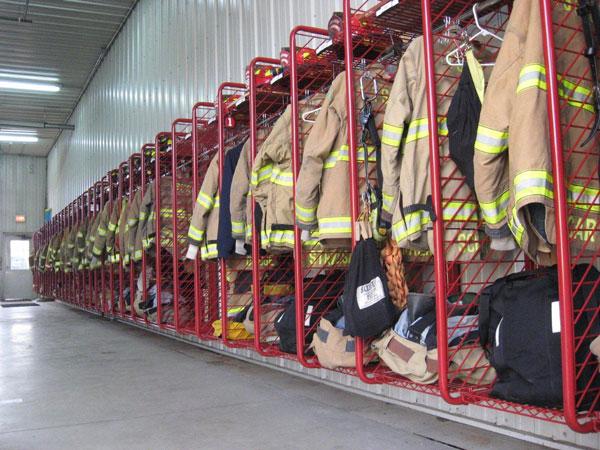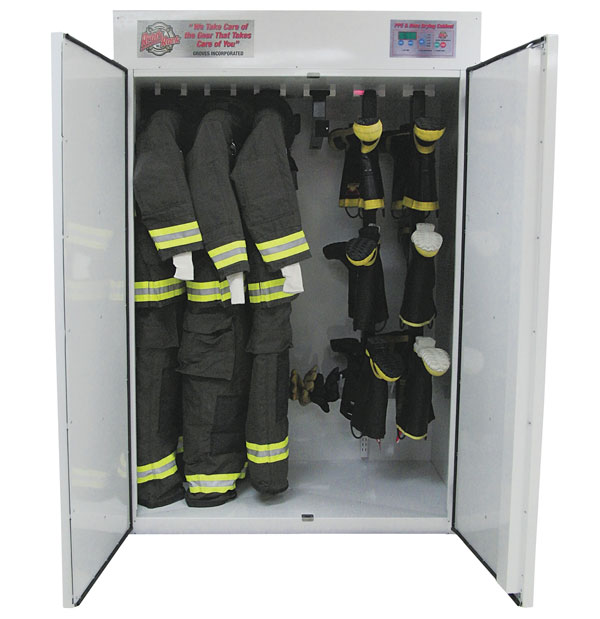
By Chris Sheppard
A lot has changed in the nearly 15 years that I’ve been involved in the fire and rescue industry. From post 9/11 influxes of grant money to recession-driven station closures, the one constant has always been the advancement of firefighter safety. Modern personal protective equipment (PPE) features lighter, high-tech fabrics designed to shield better, yet allow for maximum movement and durability. There are also new safety and health protocols that require the gear to be washed after a run to remove possible contaminants and carcinogens. Obviously, today’s PPE represents a quantum leap in personal protection for the firefighter, but also presents a multitude of new care and storage issues for station designers.
The first things you need to do when retrofitting your PPE care and storage system is to develop a list of the upgrades that you feel are necessary, and of course, the budget figure that you’ll need to acquire them. Since this is not an article about obtaining grants, I’ll leave the funding to experts in that field and focus on the cleaning, storage, and access of your gear.
Many older stations are already filled to capacity with more equipment and apparatus than they were ever intended to house. You need to look at the organization of not just the PPE, but all the surplus gear, hoses, SCBA, and tools to maximize your square footage. If you need to install a new industrial washer and dryer in a station that was built in 1950, where are you going to put them and what’s in that space right now? This equipment will also require building-code-approved electrical, gas, water, sewage, and ventilation systems, so it is recommended to hire professional licensed contractors. We wouldn’t want to be responding to an extra alarm fire at our own station, would we?
Ideally, you have a storage room right off the apparatus bay or an area in the back of the bay that can be converted into a PPE-only laundry. This will save the hassle and contamination risks of dragging soiled PPE through the living quarters. Take an inventory of everything in the room and place a level of importance on it—surplus hose, air cylinders, and backboards rate higher than Christmas lights! You want to reduce as much of the accumulated clutter as possible and prioritize the valuable gear for long term storage. There are now a great many options for specialized surplus gear storage that can get it off the floor and organized so that you can convert that coveted floor space. Choosing a modular system that was designed to stand up to the rugged demands of the Fire Service over a big box store product made for residential use will pay dividends for years to come. I know many of you are saying “Lots of our guys work in the trades, they could just build something for less money.” Maybe, but unlikely when you consider the cost of materials, labor, time, and insurance liability.
Specifying the washing and extracting machines is not difficult, since there are many fine manufacturers marketing their equipment specifically to fire departments. A great deal depends on the capacity you need based on your station size and the number of runs you handle per year. This goes the same for drying units, which include traditional tumble dry style and newer drying cabinets. Some PPE manufacturers specify drying cabinets for their brands incorporating the latest technology materials, so it is advisable to check with your supplier before ordering a drying system. Once you have made your decisions, download the manufacturer’s installation paperwork and meet with your contractors. Make sure you are all on the same page to avoid connection hassles and cost overruns. A couple of hours at the conference table can literally save thousands of dollars and weeks of frustration.
Outfit the PPE laundry with short-term hanging stations and wheeled racks to facilitate moving the gear to the firefighter’s storage area. It’s a little thing that is often overlooked, but can help to streamline the mundane process of doing laundry.
You want your turnout gear to be organized, and you want your crew to have easy access to it so you can respond to a call without delay. It sounds like common sense, so take a common sense approach to it.
Many older stations hang the PPE on the walls next to the apparatus or in dedicated dressing rooms adjacent to the apparatus bays. While these systems have worked for well over a century that is not to say that it can’t be improved upon. If you’re still using coat hooks and closet rods or some improvised locker design to hold your gear, you’re wasting time and space. Modern wall mounted storage racks are stronger, more organized, and with neatly divided units, each crew member’s equipment is compartmentalized for rapid access.
The keys to this concept are available wall space, department headcount, and storage section width. Most manufacturers offer several widths of section to accommodate differences in wall runs. Another factor to consider is community growth and departmental expansion. You never know when you’ll have to put a few more firefighters on, so plan in advance if you can. Multiply your headcount (including future growth) by the desired section width and subtract it from wall length. If you get a negative number, you need to make up units with free standing or mobile racks. Mobile Racks offer the advantage of convenient placement near the apparatus and the mobility to clean under and around while freestanding units are more permanent.
When specifying the wall-mounted storage rack, factor in the placement of electrical outlets, light switches, exposed conduit and piping. Will the rack obstruct access to, or require you to “skip a space” for an outlet? Are there available wall spacers that can bridge over a pipe? If so, make sure to order them along with the racks to avoid installation delays. Modern storage racks also offer the additional option of lockable security doors. While security options are often considered essential in large urban departments, you should not overlook them if your rural station is left empty during a call. It is not just about the investment in equipment, but about being ready to properly respond should you need all hands.
If a rack is located in a position where the PPE is exposed to direct sunlight, you may want to consider adding a UV blocking shade to the rack. This will greatly extend the service of the PPE and also help to keep diesel soot and other contaminants off your gear between runs.
As PPE has become more advanced, and more expensive, it has become more and more important to take better care of the gear that takes care of you. From properly washing and drying to smart and organized storage solutions, investing in the right equipment will serve your department and your community for years to come.
For more information, visit www.readyrack.com.
CHRIS SHEPPARD is the media manager at Groves Incorporated.




